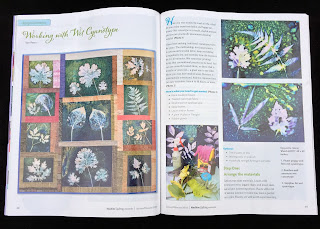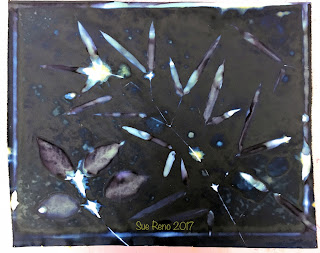Once again, I had packed away my supplies, but the weather remained mild, and my obsession with and curiosity about the wet cyanotype process remains dialed up to 11, so here we are again. There had been mild frosts, but no hard freeze, so there were still some scraps of leaves about. I had a warmish, sunny day on tap, but no treated fabric on hand. I realized I could experiment with really putting the "wet" in wet cyanotype, and start with fabric freshly painted with the cyanotype chemicals. I started with a 16" x 20" piece of cotton sateen and some sweetgum leaves, wood poppy leaves, and a christmas fern frond. I was gratified to see that the reaction began immediately upon exposure.
Next I tried a 10" x 12" exposure of a sweetgum leaf:
It also colored up right away:
So I added a wood poppy/sweetgum print:
A wood poppy/damaged pulmonaria leaf/holly fern:
Some golden raspberry leaves:
and wood poppy with big root geranium:
The first four were set out on my deck with indirect sunlight, but the last two I set in the driveway in the direct sun. The immediate reaction was this lovely rich teal color:
I like to leave prints out for 24 hours if possible, because overnight the moisture condenses on the glass and adds to the movement of the chemicals on the fabric. On this night the temperature dipped below freezing, and two of the prints which were up on a table got a bit frosty.
It was exciting but (spoiler alert) didn't seem to change the resulting print in any significant way.
Here are the finished, dried, but un-rinsed prints:
There's lots of deep, dark color in the background, and very subtle color shifting.
The two that got direct bright sun immediately upon exposure also got a bit splotchy.
Here are the finished prints. I think they are quite lovely. You can click on any image to enlarge it.
There is a lot of contrast in this batch. The masked, unexposed areas under the leaves are very bright and white.
I think because the fabric was freshly treated, the chemicals in the wet areas under the leaves wicked out into the rest of the print, something like when I make a heliographic print with textile paints.
In general I think I prefer the results from pre-treated, dried fabric, but this is a good trick to have in my arsenal and I'm quite happy with the results.
If you are new here, welcome! I've been detailing and documenting my experiments with wet cyanotype in great detail; you can read it in reverse chronological order by clicking the Wet Cyanotype tab in the top header, or click here.
And a reminder that I also post on social media:
Facebook page:http://www.facebook.com/suerenostudio
Twitter feed: http://twitter.com/suereno
Tumblr: http://suerenostudio.tumblr.com
Instagram: https://www.instagram.com/sue_reno_studio/



































































